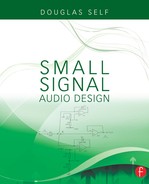Contents
Amplification Then Attenuation
Attenuation Then Amplification
Raising the Input Signal to the Nominal Level
Bipolar Transistor Voltage Noise
Bipolar Transistor Current Noise
Ultra-Low-Noise Design with Multipath Amplifiers
Ultra-Low-Noise Voltage Buffers
Copper and Other Conductive Elements
Impedances and Crosstalk: A Case History
Capacitor Non-Linearity Examined
Non-Electrolytic Capacitor Non-Linearity
Electrolytic Capacitor Non-Linearity
Chapter 3 Discrete Transistor Circuitry
Why Use Discrete Transistor Circuitry?
The Constant-Current Emitter-Follower
The Push-Pull Emitter-Follower
One-Transistor Shunt-Feedback Gain Stages
One-Transistor Series-Feedback Gain Stages
Two-Transistor Shunt-Feedback Gain Stages
Two-Transistor Series-Feedback Gain Stages
High-Input-Impedance Bipolar Stages
Chapter 4 Op-Amps and Their Properties
A Very Brief History of Op-Amps
Op-Amp Properties: Common-Mode Range
Op-Amp Properties: Input Offset Voltage
Op-Amp Properties: Bias Current
Rail bootstrapping to reduce CM distortion
Bootstrapping series-feedback JFET op-amp stages
Op-Amps Surveyed: BJT Input Types
Op-Amps Surveyed: JFET Input Types
Combined Low-Pass and High-Pass Filters
Distortion in Sallen-and-Key Filters
Multiple-Feedback Bandpass Filters
Chapter 6 Preamplifier Architectures
Amplification and the gain-distribution problem
Chapter 7 Moving-Magnet Disc Inputs
Maximum Signal Levels on Vinyl
Equalization and Its Discontents
Implementing RIAA Equalization
Passive and Semi-Passive RIAA Equalization
Calculating the RIAA Equalization Components
RIAA Equalization Component Tolerances
Simulating Inverse RIAA Equalization
Physical Inverse RIAA Equalization
Cartridge–Preamplifier Interaction
Noise Results with A-Weighting
Electronic Cartridge Loading for Lower Noise
Combining Subsonic and Ultrasonic Filters
Chapter 8 Moving-Coil Head Amplifiers
Moving-Coil Cartridge Characteristics
A New Moving-Coil Amplifier Configuration
Chapter 9 Volume and Balance Controls
The Baxandall Active Volume Control
A Practical Baxandall Active Gain Stage
Switched Attenuator Volume Controls
Relay-Switched Volume Controls
Transformer-Tap Volume Controls
Integrated Circuit Volume Controls
Chapter 10 Tone Controls and Equalizers
The Baxandall Two-Capacitor LF Control
The Baxandall Two-Capacitor Tone Control
The Baxandall Two-Capacitor HF Control
Switched-Frequency Baxandall Controls
Variable-Frequency LF and HF EQs
Fixed-Frequency Baxandall Middle Controls
Three-Band Baxandall EQ in One Stage
Switched-Q Variable-Frequency Wien Middle EQs
Switchable Peak/Shelving LF/HF EQs
Chapter 11 A Complete Preamplifier
The High-Impedance Input Buffer
Chapter 12 Mixer Architectures
The In-Line Mixing Architecture
A Closer Look at Split-Format Modules
The Channel Module (Split Format)
Talkback and Oscillator Systems
Chapter 13 Microphone Preamplifiers
Microphone Preamplifier Requirements
The Simple Hybrid Microphone Preampilifier
The Balanced-Feedback Hybrid Microphone Preampilifier
Microphone and Line-Input Pads
The Padless Microphone Preampilifier
Capacitor Microphone Head Amplifiers
The Advantages of Balanced Interconnections
The Disadvantages of Balanced Interconnections
Balanced Cables and Interference
Electronic vs. Transformer Balanced Inputs
The Basic Electronic Balanced Input
Common-Mode Rejection: The Basic Balanced Input and Op-Amp Effects
Op-Amp Frequency Response Effects
Amplifier Component Mismatch Effects
Variations on the Balanced Input Stage
Combined Unbalanced and Balanced Inputs
High-Input-Impedance Balanced Inputs
The Inverting Two-Op-Amp Input
Low-Noise Balanced Inputs in Real Life
Ultra-Low-Noise Balanced Inputs
Switching with CMOS Analog Gates
Control Voltage Feedthrough in CMOS Gates
JFETs in Voltage Mode: The Series JFET Switch
The Shunt JFET Switch in Voltage Mode
Reducing Distortion by Biasing
Dealing with the DC Conditions
Control-voltage feedthrough in JFETs
Ground-Canceling Summing Systems
Balanced Hybrid Summing Amplifiers
Talkback Microphone Amplifiers
Console Cooling and Component Lifetimes
Chapter 18 Level Indication and Metering
A More Efficient LED Bar-Graph Architecture
Chapter 19 Level Control and Special Circuits
Operational Transconductance Amplifiers
Active Clipping with Transistors
Using Variable-Voltage Regulators
Dual Supplies From a Single Winding
Power Supplies for Discrete Circuitry
Microcontroller and Relay Supplies
